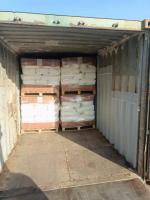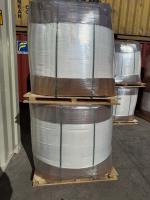Our Products
Polyacrylamide / Cationic flocculant of Praestol 644BS can be replaced by Chinafloc C6014

Cationic flocculants are vital in modern water treatment and solid-liquid separation processes due to their strong ability to neutralize negative charges and form stable, dense flocs. Among these, Praestol 644BS, produced by Solenis, is a well-known cationic polyacrylamide emulsion with medium-to-high molecular weight and a balanced cationic charge density. It is designed for efficient flocculation and dewatering of suspended solids in municipal and industrial wastewater systems, as well as in sludge management, mining, and papermaking applications. Its wide performance range and stability make it one of the most reliable cationic flocculants in the market.
1. Overview of Praestol 644BS
Praestol 644BS is a cationic water-soluble polymer used as a flocculant to separate solids from liquids. Its structure consists of long polymer chains containing positively charged functional groups that readily adsorb onto the negatively charged surfaces of suspended particles in water. Through electrostatic attraction and polymer bridging, these particles aggregate to form large, easily separable flocs. The process improves sedimentation, filtration, and centrifugation efficiency, leading to clearer water and drier sludge.
Because it combines a strong charge density with high molecular weight, Praestol 644BS works effectively even in complex systems with varying pH levels, temperature ranges, and suspended solids characteristics.
2. Municipal Wastewater Treatment
One of the most widespread uses of Praestol 644BS is in municipal wastewater treatment, particularly during sludge thickening and dewatering stages. Waste activated sludge from biological treatment processes contains fine, negatively charged particles that do not settle easily and hold significant amounts of water.
When Praestol 644BS is added, its cationic groups attach to these negatively charged solids, neutralizing surface charges and forming larger, denser flocs. These flocs improve the performance of centrifuges, belt filter presses, and screw presses, allowing for faster dewatering and producing a sludge cake with higher solids content. The result is a significant reduction in sludge volume, lower transportation and disposal costs, and improved filtrate quality.
Additionally, Praestol 644BS enhances the efficiency of sludge thickening units such as gravity thickeners and dissolved air flotation (DAF) systems by promoting rapid solid-liquid separation. It also helps stabilize operations under fluctuating organic loads and changing wastewater characteristics.
3. Industrial Wastewater Treatment
Praestol 644BS is extensively used in industrial effluent treatment, especially in sectors such as textiles, pulp and paper, food and beverage, petrochemicals, and metal finishing. Industrial effluents often contain negatively charged organic materials, dyes, oils, and suspended solids that are difficult to remove using conventional methods.
In textile wastewater treatment, the cationic flocculant is highly effective in removing color and reducing chemical oxygen demand (COD) by flocculating anionic dye molecules. It destabilizes dye dispersions and forms compact flocs that settle or filter rapidly.
In food and beverage industry effluents, Praestol 644BS aggregates proteins, fats, and suspended organic matter, improving effluent clarity and reducing total suspended solids (TSS).
In chemical and petrochemical wastewater, it acts as a secondary flocculant after inorganic coagulants like alum or ferric chloride, polishing the treated water and improving sludge handling. Its ability to function over a wide pH range (typically 4–10) makes it suitable for a variety of process conditions.
The polymer’s strong bridging and adsorption properties lead to efficient turbidity reduction, oil-water separation, and COD removal, helping industries meet strict discharge standards while improving recycling and reuse of treated water.
4. Sludge Dewatering and Thickening
A critical area where Praestol 644BS excels is sludge dewatering. In wastewater treatment, large volumes of sludge are generated, typically containing 95–99% water. Removing this excess water is crucial for cost-effective disposal. Praestol 644BS facilitates the aggregation of fine solids and enhances drainage by forming robust flocs that retain less water.
When used in belt filter presses, it reduces the need for excessive pressure, increases throughput, and improves cake dryness. In centrifuges, it promotes rapid solid-liquid separation and reduces energy consumption. The sludge cake produced is more compact, easier to handle, and less odorous, providing significant economic and environmental benefits.
Moreover, in gravity thickeners, Praestol 644BS increases the solids concentration in the underflow and enhances overflow clarity, making subsequent treatment processes more efficient.
5. Papermaking and Pulp Processing
In the pulp and paper industry, Praestol 644BS acts as a retention and drainage aid, charge neutralizer, and pitch control agent. Paper stock typically contains negatively charged fibers, fillers, and additives. Excess anionic charge can cause instability, foaming, and poor retention of fines and fillers.
By neutralizing these charges, Praestol 644BS improves filler retention, enhances sheet formation, and stabilizes the wet end of the paper machine. This leads to higher paper strength, reduced waste, and improved drainage on the wire section, increasing production speed.
Additionally, it controls pitch and resin deposits by flocculating sticky anionic contaminants that might otherwise accumulate on machine surfaces. When used in combination with microparticle systems like bentonite or colloidal silica, it delivers superior retention and drainage performance, ensuring consistent paper quality.
6. Mining and Mineral Processing
Praestol 644BS is also employed in mineral processing and mining applications, where efficient solid-liquid separation is vital. In processes such as coal washing, bauxite refining, and metal ore flotation, fine negatively charged particles tend to remain suspended, leading to turbid process water and low settling rates.
The addition of Praestol 644BS promotes rapid sedimentation by flocculating these fines into dense aggregates, enhancing clarifier and thickener performance. It increases underflow solids concentration, improves overflow clarity, and allows for greater water recovery and recycling within the plant.
In tailings management, the polymer assists in thickening and dewatering tailings, reducing storage volumes and minimizing environmental impact. Its stable performance in high-salinity and variable pH environments makes it particularly useful for mining operations in harsh conditions.
7. Oilfield and Petrochemical Applications
In oilfield operations, Praestol 644BS serves as a demulsifier and clarification aid in produced water treatment. It flocculates fine oil droplets, suspended solids, and clays, enhancing oil-water separation and improving water clarity before reinjection or discharge.
In refineries and petrochemical facilities, it is used to clarify process water and treat oily wastewater, ensuring compliance with environmental regulations. Its high cationic charge and stability make it effective under extreme temperature and chemical conditions, where other polymers might degrade.
8. Advantages of Praestol 644BS
Praestol 644BS offers multiple benefits compared to traditional inorganic coagulants. It requires lower dosages, produces less sludge, and operates effectively over a broad pH range. Its emulsion form ensures fast dissolution and easy application through automatic dosing systems. The polymer also has low toxicity and non-corrosive properties, making it safe for operators and environmentally responsible.
It can be used alone or in combination with other coagulants such as polyDADMAC, polyamine, or metal salts to enhance performance and tailor floc characteristics for specific applications.




472_small.jpg)